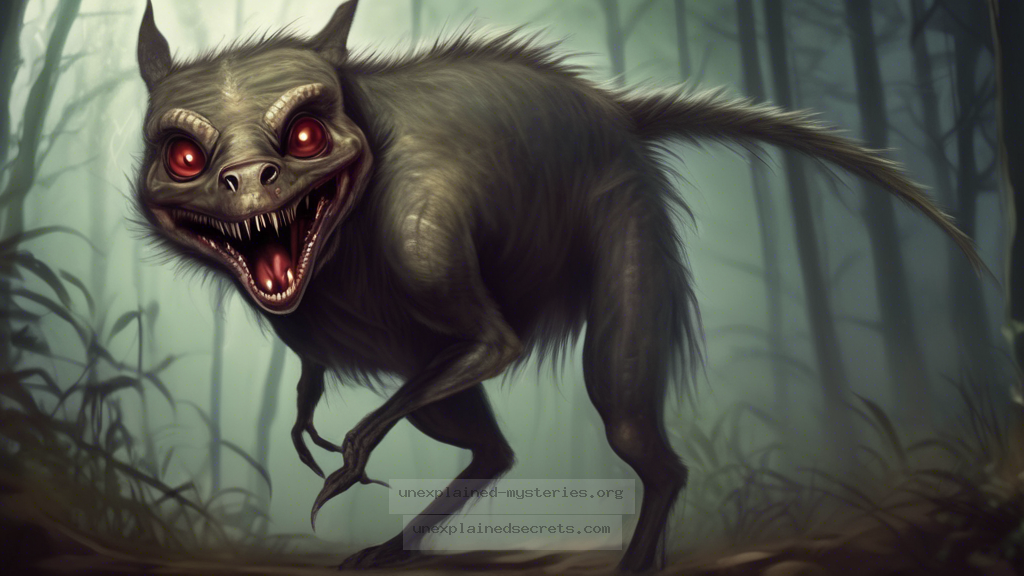Is the Chupacabra the Most Misunderstood Cryptid of All Time?
Is the Chupacabra the Most Misunderstood Cryptid of All Time?
The Chupacabra, a creature cloaked in mystery and controversy, has fascinated cryptozoologists and paranormal enthusiasts alike for decades. This infamous cryptid, often described as a blood-sucking beast with reptilian features, has become emblematic of the unexplained creatures that lurk within the shadows of our understanding. But is the Chupacabra truly the most misunderstood cryptid of all time? To answer this question, we must delve into its origins, reported sightings, scientific investigations, and the cultural implications that have shaped its legacy.
Historical Context of the Chupacabra
The legend of the Chupacabra first emerged in Puerto Rico in the mid-1990s. Reports indicated that livestock, particularly goats, were mysteriously found dead, drained of blood with three puncture wounds on their necks. The term “Chupacabra” translates to “goat-sucker” in Spanish, aptly named for its alleged penchant for feasting on livestock. The first widely publicized sighting was reported by a woman named Madelyne Tolentino in 1995, who described encountering a creature that resembled a reptilian dog. Since then, the Chupacabra narrative has evolved, spawning various interpretations and sightings across the Americas, each adding layers to its mythos.
Key Point: The Chupacabra legend gained traction in the mid-1990s, with the first sightings reported in Puerto Rico.
Core Concepts and Theories Surrounding the Chupacabra
Various theories have emerged to explain the Chupacabra phenomenon. Some suggest it could be a previously undiscovered species, while others view it as a manifestation of collective anxiety or folklore. A popular theory posits that the Chupacabra is a canine-like creature suffering from mange, which can cause severe hair loss, giving it a gaunt and alien appearance. This theory gained traction when images of supposed Chupacabras were later identified as hairless dogs, such as coyotes or raccoons, afflicted by the disease.
| Theory | Description |
|---|---|
| Undiscovered Species | Some believe the Chupacabra is a new or undiscovered species of animal. |
| Cultural Reflection | It may represent societal fears or anxieties projected onto a mythical creature. |
| Mange Theory | Some Chupacabra sightings can be attributed to animals with mange, leading to misidentification. |
Practical Evidence and Investigations
Despite the plethora of anecdotal evidence and claims, scientific investigations into the Chupacabra have yielded limited results. In 2010, researchers in Texas claimed to have discovered a creature that matched descriptions of the Chupacabra. DNA testing ultimately revealed it to be a coyote with severe mange. This finding highlighted not only the challenges of identifying cryptids but also the tendency for sensationalism surrounding cryptid sightings.
Moreover, a 2015 study published in the journal “Cryptozoology” analyzed various reports and concluded that many sightings can be attributed to misidentified animals. The researchers noted that as people become more familiar with wildlife, the instances of misidentification decrease, suggesting that many Chupacabra reports stem from a lack of understanding of local fauna.
Alternative Perspectives on the Chupacabra
Some skeptics argue that the Chupacabra is simply a modern myth, a creation of folklore that has evolved over time. This perspective emphasizes the role of cultural narratives in shaping our understanding of the unknown. The Chupacabra can be seen as a reflection of societal fears, particularly in regions where agricultural communities face challenges such as livestock predation.
Furthermore, it raises questions about how stories of the Chupacabra have been manipulated for entertainment or sensational news coverage. The media’s portrayal of the Chupacabra has often sensationalized reports, leading to a cycle of myth-making rather than objective investigation.
Cautionary Note: Be wary of sensationalized media reports that may distort the reality of cryptid sightings.
Common Misconceptions and Clarifications
One of the most prevalent misconceptions regarding the Chupacabra is its appearance. Many depictions show it as a monstrous creature with sharp fangs and glowing eyes. However, eyewitness descriptions vary widely, leading to confusion and often conflicting interpretations. Some describe it as a small, hairless creature, while others depict it as a large, dog-like figure.
Additionally, many believe the Chupacabra is solely a Puerto Rican phenomenon, when in fact sightings have been reported throughout the Americas. From Chile to the southern United States, the Chupacabra has taken on various local characteristics, reflecting the cultural context of each region.
Best Practices for Investigation or Study
For those interested in investigating the Chupacabra phenomenon, there are several best practices to follow. First and foremost, it is crucial to approach claims with skepticism and a scientific mindset. Collecting evidence through photographs, eyewitness accounts, and biological samples can help build a more comprehensive understanding of the claims surrounding the Chupacabra.
Engaging with local folklore and understanding the cultural significance of the Chupacabra can also provide valuable context. Researchers should consider collaborating with local wildlife experts to differentiate between known species and potential cryptids. This multidisciplinary approach can lead to more accurate conclusions and a deeper understanding of the Chupacabra mythos.
Future Developments and Ongoing Research
The future of Chupacabra research remains uncertain, but ongoing advancements in DNA testing and wildlife tracking technologies may provide valuable insights. As technology evolves, researchers may find new ways to analyze reported sightings and gather evidence. Citizen science initiatives, where locals can contribute to data collection, could also play a role in expanding the body of knowledge surrounding cryptid investigations.
Moreover, the Chupacabra’s status as a cultural icon ensures that it will remain a topic of interest. As long as stories continue to circulate, the possibility of new sightings or interpretations will persist, adding to the rich tapestry of cryptozoological lore.
Future Insight: Advances in technology may enhance our understanding of cryptids like the Chupacabra.
Conclusion: The Chupacabra as a Symbol of the Unknown
The Chupacabra serves as a fascinating example of how myths and narratives can shape our understanding of the natural world. Whether seen as a misunderstood creature, an expression of cultural fears, or a reflection of societal anxieties, the Chupacabra encapsulates the allure of the unknown. As we continue to investigate and explore the realms of cryptozoology, the Chupacabra will undoubtedly remain a captivating subject ripe for inquiry and debate.
In answering whether the Chupacabra is the most misunderstood cryptid of all time, it is clear that its legacy is complex and multifaceted. The intersections of folklore, science, and human experience make it a compelling case study in the world of cryptids. The Chupacabra challenges us to question our perceptions and explore the boundaries of our understanding, reminding us that the world is still full of mysteries waiting to be uncovered.
Other Articles
Recent Posts
- What Happened to Flight MH370? The Conspiracy Theories That Still Haunt Us
- What Secrets Lurk Within the Walls of the Infamous Trans-Allegheny Lunatic Asylum?
- What Evidence Supports the Existence of Bigfoot in the Pacific Northwest?
- What Happened to the Indus Valley Civilization? Unraveling the Mysteries of Ancient Urban Life
- Can Telepathy Be Scientifically Proven Through Laboratory Evidence?







